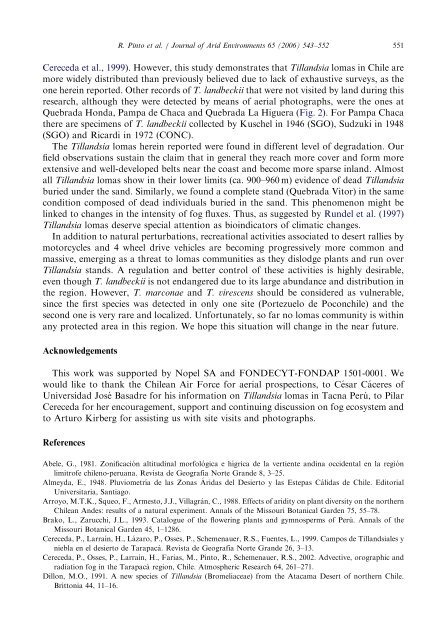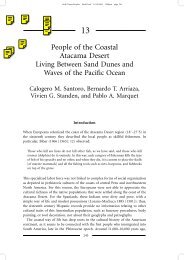Geographical distribution of Tillandsia lomas in the Atacama ... - IEB
Geographical distribution of Tillandsia lomas in the Atacama ... - IEB
Geographical distribution of Tillandsia lomas in the Atacama ... - IEB
Create successful ePaper yourself
Turn your PDF publications into a flip-book with our unique Google optimized e-Paper software.
Cereceda et al., 1999). However, this study demonstrates that <strong>Tillandsia</strong> <strong>lomas</strong> <strong>in</strong> Chile aremore widely distributed than previously believed due to lack <strong>of</strong> exhaustive surveys, as <strong>the</strong>one here<strong>in</strong> reported. O<strong>the</strong>r records <strong>of</strong> T. landbeckii that were not visited by land dur<strong>in</strong>g thisresearch, although <strong>the</strong>y were detected by means <strong>of</strong> aerial photographs, were <strong>the</strong> ones atQuebrada Honda, Pampa de Chaca and Quebrada La Higuera (Fig. 2). For Pampa Chaca<strong>the</strong>re are specimens <strong>of</strong> T. landbeckii collected by Kuschel <strong>in</strong> 1946 (SGO), Sudzuki <strong>in</strong> 1948(SGO) and Ricardi <strong>in</strong> 1972 (CONC).The <strong>Tillandsia</strong> <strong>lomas</strong> here<strong>in</strong> reported were found <strong>in</strong> different level <strong>of</strong> degradation. Ourfield observations susta<strong>in</strong> <strong>the</strong> claim that <strong>in</strong> general <strong>the</strong>y reach more cover and form moreextensive and well-developed belts near <strong>the</strong> coast and become more sparse <strong>in</strong>land. Almostall <strong>Tillandsia</strong> <strong>lomas</strong> show <strong>in</strong> <strong>the</strong>ir lower limits (ca. 900–960 m) evidence <strong>of</strong> dead <strong>Tillandsia</strong>buried under <strong>the</strong> sand. Similarly, we found a complete stand (Quebrada Vitor) <strong>in</strong> <strong>the</strong> samecondition composed <strong>of</strong> dead <strong>in</strong>dividuals buried <strong>in</strong> <strong>the</strong> sand. This phenomenon might bel<strong>in</strong>ked to changes <strong>in</strong> <strong>the</strong> <strong>in</strong>tensity <strong>of</strong> fog fluxes. Thus, as suggested by Rundel et al. (1997)<strong>Tillandsia</strong> <strong>lomas</strong> deserve special attention as bio<strong>in</strong>dicators <strong>of</strong> climatic changes.In addition to natural perturbations, recreational activities associated to desert rallies bymotorcycles and 4 wheel drive vehicles are becom<strong>in</strong>g progressively more common andmassive, emerg<strong>in</strong>g as a threat to <strong>lomas</strong> communities as <strong>the</strong>y dislodge plants and run over<strong>Tillandsia</strong> stands. A regulation and better control <strong>of</strong> <strong>the</strong>se activities is highly desirable,even though T. landbeckii is not endangered due to its large abundance and <strong>distribution</strong> <strong>in</strong><strong>the</strong> region. However, T. marconae and T. virescens should be considered as vulnerable,s<strong>in</strong>ce <strong>the</strong> first species was detected <strong>in</strong> only one site (Portezuelo de Poconchile) and <strong>the</strong>second one is very rare and localized. Unfortunately, so far no <strong>lomas</strong> community is with<strong>in</strong>any protected area <strong>in</strong> this region. We hope this situation will change <strong>in</strong> <strong>the</strong> near future.AcknowledgementsThis work was supported by Nopel SA and FONDECYT-FONDAP 1501-0001. Wewould like to thank <strong>the</strong> Chilean Air Force for aerial prospections, to Ce´sar Cáceres <strong>of</strong>Universidad Jose´ Basadre for his <strong>in</strong>formation on <strong>Tillandsia</strong> <strong>lomas</strong> <strong>in</strong> Tacna Peru´, to PilarCereceda for her encouragement, support and cont<strong>in</strong>u<strong>in</strong>g discussion on fog ecosystem andto Arturo Kirberg for assist<strong>in</strong>g us with site visits and photographs.ReferencesARTICLE IN PRESSR. P<strong>in</strong>to et al. / Journal <strong>of</strong> Arid Environments 65 (2006) 543–552 551Abele, G., 1981. Zonificación altitud<strong>in</strong>al morfolo´gica e hígrica de la vertiente and<strong>in</strong>a occidental en la regio´nlimítr<strong>of</strong>e chileno-peruana. Revista de Geografía Norte Grande 8, 3–25.Almeyda, E., 1948. Pluviometría de las Zonas Áridas del Desierto y las Estepas Cálidas de Chile. EditorialUniversitaria, Santiago.Arroyo, M.T.K., Squeo, F., Armesto, J.J., Villagrán, C., 1988. Effects <strong>of</strong> aridity on plant diversity on <strong>the</strong> nor<strong>the</strong>rnChilean Andes: results <strong>of</strong> a natural experiment. Annals <strong>of</strong> <strong>the</strong> Missouri Botanical Garden 75, 55–78.Brako, L., Zarucchi, J.L., 1993. Catalogue <strong>of</strong> <strong>the</strong> flower<strong>in</strong>g plants and gymnosperms <strong>of</strong> Perú. Annals <strong>of</strong> <strong>the</strong>Missouri Botanical Garden 45, 1–1286.Cereceda, P., Larraín, H., Lázaro, P., Osses, P., Schemenauer, R.S., Fuentes, L., 1999. Campos de <strong>Tillandsia</strong>les yniebla en el desierto de Tarapacá. Revista de Geografía Norte Grande 26, 3–13.Cereceda, P., Osses, P., Larraín, H., Farias, M., P<strong>in</strong>to, R., Schemenauer, R.S., 2002. Advective, orographic andradiation fog <strong>in</strong> <strong>the</strong> Tarapacá region, Chile. Atmospheric Research 64, 261–271.Dillon, M.O., 1991. A new species <strong>of</strong> <strong>Tillandsia</strong> (Bromeliaceae) from <strong>the</strong> <strong>Atacama</strong> Desert <strong>of</strong> nor<strong>the</strong>rn Chile.Brittonia 44, 11–16.
















